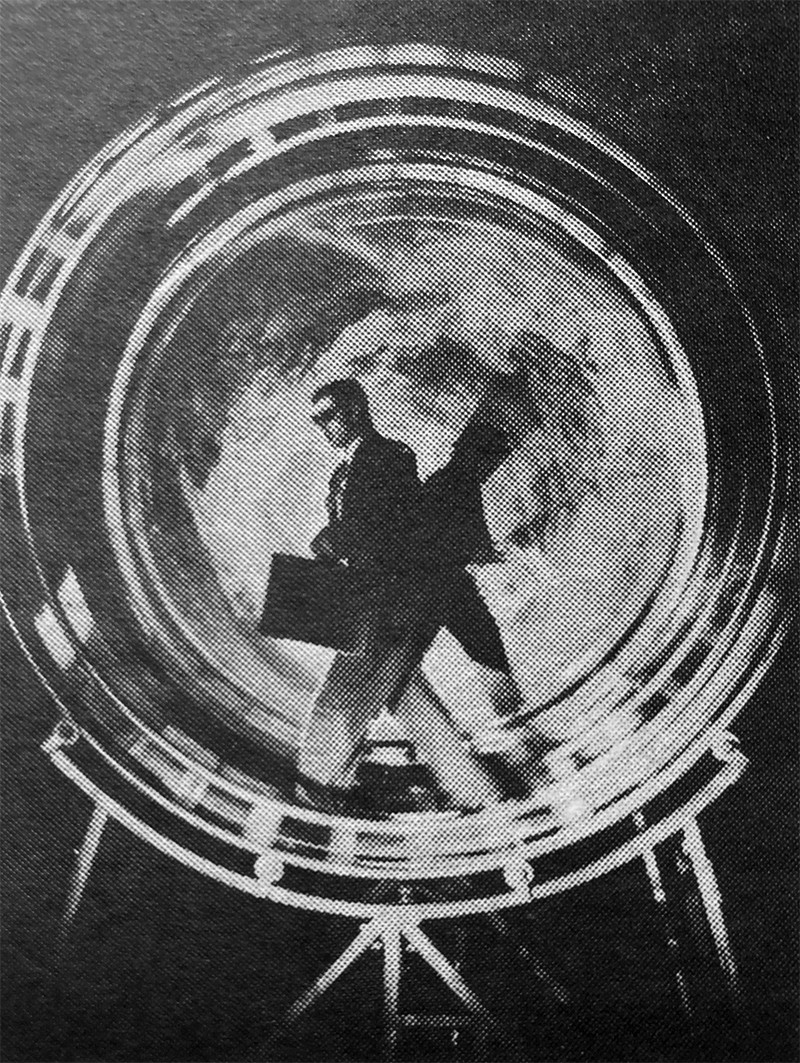Lost in the Memory Palace — Barcelona, Spain

“Running on the Hamster Wheel of Life” from Memory Palace in Barcelona, Spain. (Photo by Franc Aleu)
By MICHAEL McGETTIGAN
Big Shout Magazine, May 1992
Editor’s note: Michael McGettigan, Big Shout’s correspondent in Spain, checks in this month with the first in a series of stories from Barcelona, home of the 1992 Olympic Games.
BARCELONA — In front of me, a 35 ft. tall mechanical horse/chess piece/siege tower was pushing into the fleeing crowd, steel pincers held high. On either side, blocking my escape routes, were two muscular men encased in rolling, horse-shaped platforms: punk centaurs, swinging torches at an audience which was already dazed from concussion bombs popping off just a few feet overhead. There were also four stadium-sized video screens and a punchy, acid-house soundtrack running full blast.
The flyers for Memory Palace promised an “interactive” experience — and they weren’t kidding.
On April 4 and 5, Art Futura, Barcelona’s festival of the avant garde, presented the debut of Memory Palace, a collaborative multi-media work which closed a five-day futurist conference here.
The credits for Memory Palace read like a Who’s Who of the pop world — text by cyperpunk author William Gibson; live action directed by Pep Gatell of Barcelona’s hardcore performance art group La Fura dels Baus; video by Mark Neale, Grant Gee, and Mark Pellington of MTV “Buzz” fame; and music direction by former Led Zeppelin member John Paul Jones, with musical contributions by Jones, Peter Gabriel, and Barcelona’s multi-media rockers The Gringos, among others.
Like the super groups of the 1970s, such superstar collaborations always run the risk of collapsing in a welter of conflicting ideas. But Memory Palace, an hour-long ’90s happening presented in a factory-like concert hall, thrives on post modern MTV chaos.
Four huge video screens, crisper and brighter than any I’ve ever seen, were arranged in an arc along one side of the space, and a battery of lasers and lighting gear hung from the deserted bleachers. From behind temporary walls, stagehands rolled out minimalistic props, most made from steel scaffolding material. On these the performers climbed, danced, sang, and more than once menaced the audience of about 2,000.
The use of multi-media had the interesting effect of dividing the audience — some treated the performers as a distraction, eyes glued to the huge screens, only watching out to avoid being run over. Others talked impatiently between the live bits, barely watching the video. I opted for the tennis-match technique, bobbing my neck back and forth in a futile attempt to see everything at once.
On the screens, a dizzying array of images flashed by — computer generated fantasies, clips of kitschy 1950s commercials and an array of “reality-based” footage. This included live-action sequences of the performers, clips of politicians ranting, and perhaps most upsetting, scenes (mercifully short) of concentration camp victims being bulldozed into piles, abdominal surgery (in gory color), and miscellaneous war-time carnage.
Some of the most unlikely footage was also the most riveting: a dead and decaying fox in a forest, filmed in time delay as it slowly dried, shrank, and vanished; or a wet dog shaking in ultra slow motion. While the computer generated video was often beautiful, it lacked impact.
There were triumphant moments of virtual reality. At one point, to powerful effect, all four screens synced up to simulate a nighttime aircraft landing. For an instant, the screens became windows, as the entire space appeared to swoop in for a landing — fabulous. But the majority of the computer generated images were still smooth and superficial — compared both to the filmed images they shared the screen with and the outrageous costumes and antics of the live performers.
Besides the aforementioned mechanical horse and centaurs sequence, there was also a startling allegory: two briefcase-wielding businessmen, running at top speed inside giant transparent hamster wheels — funny, pathetic, and ominous all at once. Equally snappy was a comic battle between four vinyl-clad women warriors and two hapless males inside spiked rubber balls.
When these staged events were in full swing, video took second place — the complexity and unpredictability of plain old reality was still far more addictive, more horrifying, and funnier than anything yet programmed. This is not to take anything away from the success of Memory Palace as an unprecedented multi-media jam session. You’ll be able to see it soon if you’re visiting Spain this summer or early next year when it tours the United States.
Angels Bronsoms, a spokesperson for Art Futura, says Memory Palace will open at the Expo in Seville this June, then return to Barcelona in September. She adds that author William Gibson will read his narration when the exhibit makes its American debut in the spring of 1993, and notes that the U.S. production may be a little less aggressive when it comes to assaulting the audience.
“In Spain, we are more used to these kinds of activities,” Bronsom laughs, “but promoters elsewhere tell us, ‘my God, these fire bombs are impossible in our country!”